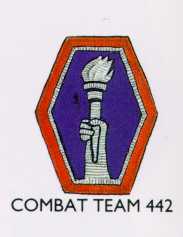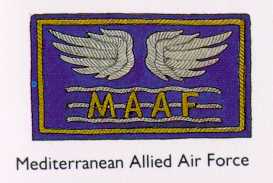3rd
"Marne"

HISTORY
|
The
3rd
Division arrived early and participated in Sicily campaign and Anzio.
On
10 July 1943, the Division made an assault landing on Sicily, fought
its
way into Palermo, and raced on to capture Messina. Nine days
after
the Italian invasion, 18 September 1943, the 3d landed at Salerno and
in
intensive action drove to and across the Volturno and to Cassino.
After a brief rest, it held the line at Anzio for 4 months. On 29
February 1944, the 3d fought off an attack by three German
Divisions.
After the fall of Rome, the 3rd began training for landing in Southern
France. On 15 August 1944, the Division landed at St. Tropez,
thus
beginning its campaign in France.
This division still
exists and
saw service in Iraq(2003).
7, 15, 30
Regiments;
10, 39, 41, 10 FA; 3 Engr
Sicily: Sept - Aug
43. Italy:
18 Sept 1943 - July 1944, France |
34th
"Red Bull"
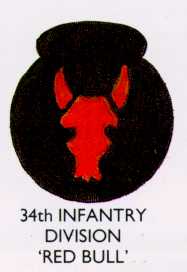 HISTORY HISTORY
|
The
34th Division
was one of the first US divisions to be sent to Europe and saw more
combat
service than almost any US division; 500 days. The 34th departed
overseas in May 1942 and continued its training in Ireland. It
served
in North Africa from 8 Novermber 1942 until May 1943. The 151st
FA
landed in Salerno invasion, with the Division following on 25
September.
It took Mount Trocchio after a bitter fight, crossed the Rapido,
attacked
Monastery Hill, and fought its way into Cassino, being relieved 13
February
1944. After a rest, it advanced again on 23 May, taking Cisterna
and Civitavecchia. It liberated Livorno, 19 July 1944, and
continued
on to take Mount Belmonte. In the Spring attack, it captured
Bologna
on 21 April, 1945.
CG: Maj-Gen Charles L. Bolte
replaced
by Gen. Charles W. Ryder
133, 135, 168
Regiments;
125, 151, 175, 185 FA; 109 Engr |
36th
"Texas"
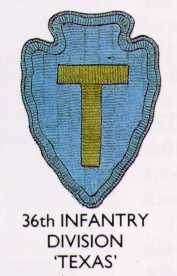 HISTORY HISTORY
|
The
36th Division
was one of the divisions that landed in Italy at Salerno. (I had an
uncle
in 36th who was taken prisoner at Salerno.) The 36th saw heavy
action
at San Pietro Infinite and was badly mauled near Cassino during the
crossing
of Rapido River on January 22, 1944. It was transferred from
Italy
to France soon after fall of Rome.
The division was reactivated
in 2004.
141, 142, 143
Regiments;
131, 132, 133 FA; 155 Engr
Landing at Salerno Sept 43
- Aug
44 |
| 45th
"Thunderbird" |
The
45th
Division was another division that arrived in time to fight in
Sicily.
It served as the reserve for the landing at Salerno and later landed on
Anzio beach. After the fall of Rome, the 45th was pulled off the
line on June 16 and began to prepare for the landing in southern
France.
Later, the 45th was involved in the liberation of Dachau concentration
camp.
159, 179, 180
Regiments;
158, 160, 171, 189 FA; 120 Engr
Sicily & Italy:
Sept
43 - Aug 44. France; Aug 44 |
85th
"Custer"
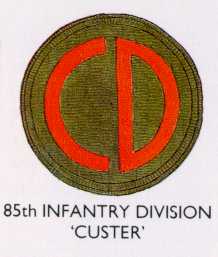
HISTORY
|
The
85th Division
was another draftee division. Organized at Camp Shelby, MS, it
also
trained in Louisana and desert warfare training in Yuma, CA. The
85th embarked from US on 25 December 1943 and stopped in North Africa
before
landing in Italy. It entered the front line on 10 April 1944,
north
of the Garigliano River. During spring offense, it took
Colacciano,
Castellonorato, and Formia, Itri and Terracina. The 85th pushed
through
Monte Compatri and Frascati, entered Rome on 5 June 1944, and advanced
to Viterbo before being relieved, 10 June. It lead the center
attack
on the Gothic Line, 13 September, taking Firenzuola on the 21st. The
85th
advanced against heavy resistance taking La Martina and gaining the
Idice
River Valley road, 2 October, and reaching Mount Mezzano on the
24th.
From southwest of Bologna, it pushed rapidly through the Po Valley,
ending
the war at
BellunoAgordo area.
[Note: Don't get this
confused
with the 85th Regiment of 10th Mountain Division or the German 85th
Mountain
Regiment.]
April 44 - Surrender
337, 338, 339
Regiments;
328, 329, 403, 910 FA; 310 Med |
88th
"Blue Devil"

HISTORY
|
The
88nd
Division was a draftee division with an outstanding record with 307
days
of combat in the Italian Campaign. After intensive training in
North
Africa, it entered front lines Garigliano River near Minturno on 5
March
1944. During the Spring Offensive, it drove through Spigno, Mount
Civita, Itri, Fondi, and Roccagorga, and reached Anzio on 29 May.
Most accounts attribute a recon team of 88th Division as the first
Allied
unit to enter Rome on June 6, 1944. After a rest, it resumed its
attack on 5 July; taking Volterra, Laiatico, Villamagna, and
crossed
the Arno on 20 July. Attacked the GOTHIC Line on 21 September
1944
along the Firenzuola-Imola Road. On 28th, it gained an advanced
postition
on Mount Battaglia where it held against repeated enemy attacks.
Took Mount Grande and Farnetto on 22 October. The drive to the Po
Valley began on 15 April, where they took Monterumici. Advanced
across
the Po, thru Verona and Vicenza, and Dolomite Alps and linked up with
Allies
in Innsbruck, Austria.
In September 1944, Maj. Gen.
John
E. Sloan was replaced by Maj. Gen. Paul W. Kendall.
March 44 - Surrender
349, 350, 351
Regiments;
337, 338, 339, 913 FA; 313 Med |
91st
"Powder River"
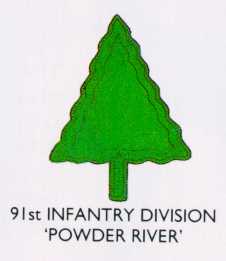
HISTORY
|
The
91st
Division entered combat for the first time on 12 July, 1944, under the
command of Maj. Gen. William G. Livesay. This division
captured
the port of Leghorn on 19 July before reaching the banks of the Arno
River.
It was heavily involved in attacks on the GOTHIC Line and the capture
of
Il Futa Pass. Its name comes from the Powder River located near
Camp
Lewis, Washington, where it was organized in WW1.
361, 362, 363
Regiments;
346, 347, 348, 916 FA 316 Med |
92nd
"Buffalo"
HISTORY
|
The
92nd
Buffalo Division was an all-black infantry division that was positioned
along the west coast of Italy late in 1944. The 370th Regiment
entered
combat on the 24 August, 1944 in support of the 1st Armored Division.
It
participated in the crossing of the Arno River, the occupation of
Lucca,
and the pentration of the GOTHIC Line. On 26 December 1944 , the
Germans launched Operation WINTERGEWITTER against the sector containing
the 92nd Division. With help from other units, the German
counter-offensive
was halted. The 442nd RCT and the 473rd Regiment (see
elsewhere in table) were sent to beef-up the 92nd Division. They
entered La Spezia and Genoa on the 27 April, 1945 and liberated several
towns along the Ligurian coast.
Activated: 15 Oct 42,
Overseas: 22Sep
44, Inactivated: 28 Nov 45
365, 370, 371
Regiments;
597, 598, 599, 600 FA, 317 Med +442RCT +473RCT |
10th
Mountain

|
The
10th
Mountain Division attracted alot of college men who trained in
Colorado.
They arrived during winter of 1944-45 in Italy and fought for only 1
week
in snow. They made a reputation for themselves with the
Germans.
The Division consisted of 85th, 86th & 87th Mountain
Regiments(which
can easily be confused with 85th Infantry Division or the German 85th
Mountain
Regiment, if you aren't careful). The most famous member of this
unit was a Lt. Robert Dole, later US Senator from Kansas. The unit
still
exists as the 10th Light Division.
85, 86, 87 Mtn
Regiments;
604, 605, 616 FA; 126 Mtn Engr Btn
Feb 1945 - May 1945 |
1st
Armored
"Old Ironsides"
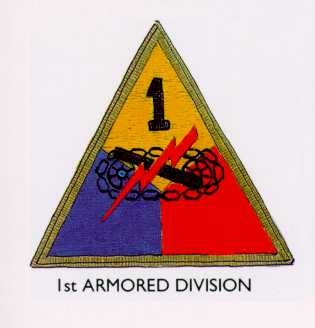
HISTORY
|
The
1st
Armored Division saw difficult service fighting Rommel's forces in
North
Africa. After some rest, it entered its first combat in
Italy
at Battle of Monte Porchia in January 1944. The 1st Armored
Division
remained in Italy throughout the war.
CG: Maj-Gen Ernest N.
Harmon
replace by Gen. Vernon E. Prichard
6, 11, 14 Armd Batln; 1, 4,
13
Tank Btln; 81 Cav Recon, 16 Armd Engr, 47 Armd Med
The Division had one major
re-organization.
Formed into "Combat Commands" for more mobile unit of combined infantry
and armor. Names were CCA & CCB.
No. Africa, Italy Dec 1943
- May
1945 |
| 6th
South African Armored |
The
6th
South African Armored Division was, of course, from South Africa, but
was
assigned to the US 5th Army. The 6th S.F. Armored and the 1st US
Armored provided tank support to the infantry divisions. |












